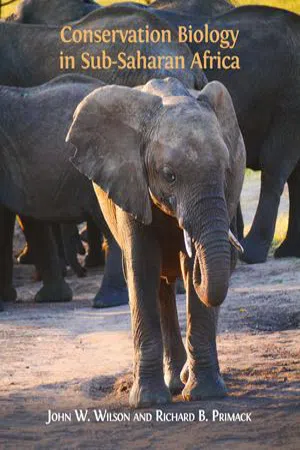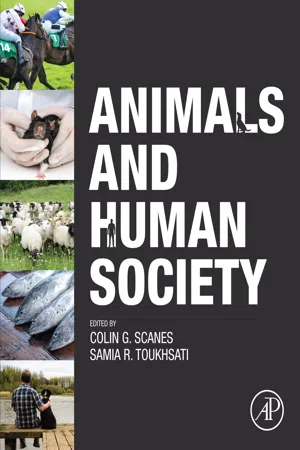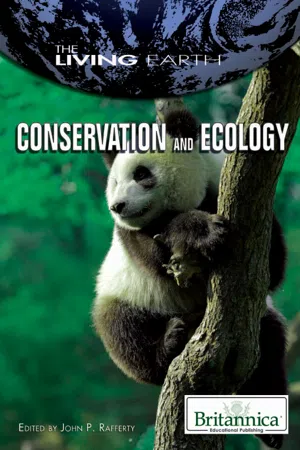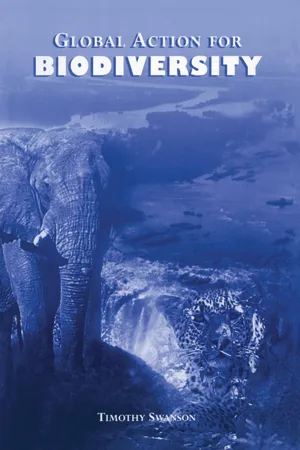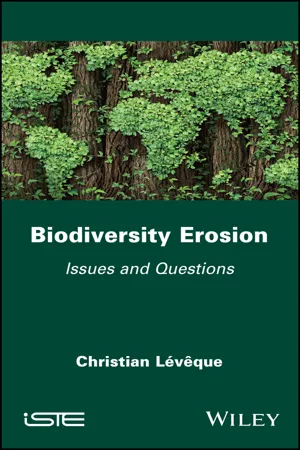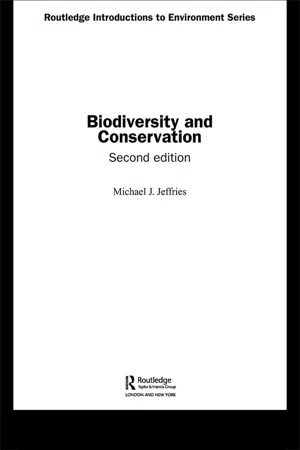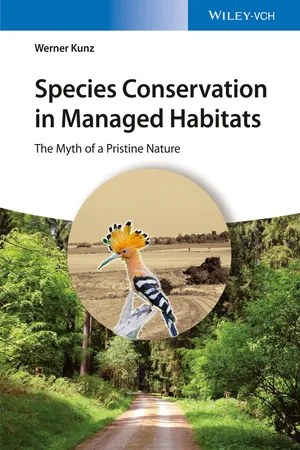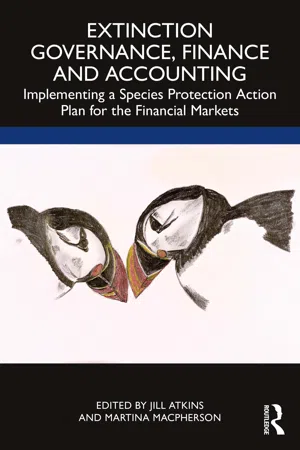Biological Sciences
Extinction
Extinction refers to the permanent disappearance of a species from the Earth. It occurs when the last individual of a particular species dies, leading to the complete loss of that species. Extinction can be caused by various factors, including habitat destruction, climate change, overhunting, and pollution. It is a natural process, but human activities have significantly accelerated the rate of extinction.
Written by Perlego with AI-assistance
Related key terms
1 of 5
12 Key excerpts on "Extinction"
- eBook - ePub
What Is Extinction?
A Natural and Cultural History of Last Animals
- Joshua Schuster(Author)
- 2023(Publication Date)
- Fordham University Press(Publisher)
While the meanings and terms associated with Extinction have shifted a number of times over the past few centuries, I want to articulate some of the broader challenges that Extinction poses for conceptualizing ecology and ecological art. Presented here are a series of central themes that form the basis of this book. They concern how Extinction has become knowable and how the consequences of such knowledge can be both powerful and unsettling to the thinker. Thinking Extinction implicates ecological thought in a number of paradoxes. To note a few: Extinction is both a biological norm and a catastrophe that casts biological norms aside. As Darwin showed, there can be both a proliferation of species and an intensification of Extinction at the same time. Extinction is central to evolutionary processes but also the radical end and undoing of these processes of speciation. The science of Extinction contributed to both the consolidation and the emptying out of the category of species. The demise of a species is a measurable and calculable event, and this empirical data has served a fundamental role for comparative anatomy, paleontology, and population ecology; yet each Extinction is an immeasurable and incalculable absence that cannot be encompassed by statistical science. The broad connotations of the concept of ecology have quasi-utopian associations of an assembled commons of life, what Darwin metaphorically called “an entangled bank.” Extinction has undeniable dystopian connotations, and its metaphors and landscapes are consistently envisioned as bleak. However, evolution, ecology, and biodiversity are made and unmade in conditions of species precarity and “injury” (Darwin’s word) that can never rule out Extinction in the midst of such entangled relationships - eBook - PDF
- W. Johnny Wilson, Richard Primack(Authors)
- 2019(Publication Date)
- Open Book Publishers(Publisher)
259 Chapter 8 | Extinction Is Forever rise of agriculture (12,000–15,000 years ago) and again during the Industrial Revolution (1760–1840), when fossil fuel usage and urbanisation became the norm. Now, many scientists recognise today’s new and distinct human-dominated geological epoch , the Anthropocene (Waters et al., 2015). One notable feature of the Anthropocene is that species Extinctions are increasing at such rapid rates that many conservation biologists now recognise that we are also witnessing the beginnings of Earth’s sixth Extinction episode (Barnosky et al., 2011; Ceballos et al., 2017). However, unlike previously, this Extinction episode is caused by human activities rather than natural events. 8.1 What is Extinction? The term “extinct” has several nuances in conservation biology, and its meaning can vary somewhat depending on the context: • A species is globally extinct when no individuals of that species remains alive anywhere in the world. The bluebuck ( Hippotragus leucophaeus , EX) has been globally Extinct since the last individual was shot around 1800 (Kerley et al., 2009). • Four (possibly seven) species of cycad ( Encephalartos spp.)—ancient seed plants that were dominant in the age of the dinosaurs— are currently considered extinct in the wild ; in other words, they exist only in cultivation; in captivity; or another human-managed situation (IUCN, 2019). • A species is locally extinct , also called extirpated , when it is extinct in a part of its historic range but can still be found elsewhere in the world. Cheetahs ( Acinonyx jubatus , VU) once roamed throughout much of Africa, but are now extirpated in over 90% of their historical range (Durant et al., 2017). • A species is ecologically extinct (also called functionally extinct ) if it persists at such low numbers that its role in an ecosystem is negligible. - eBook - ePub
- Colin G. Scanes, Samia Toukhsati(Authors)
- 2017(Publication Date)
- Academic Press(Publisher)
Chapter 21Animal Extinctions
Samia R. Toukhsati Honorary Fellow, The University of Melbourne, Parkville, VIC, AustraliaSummary
Extinctions refer to the death of a single or multiple species (or taxon) and are common in the history of life on this planet. Using the fossil record, it has been estimated that 99.9% of the species that existed on earth is now extinct. Extinctions occur when a species fails to meet or adapt to changing environmental forces (such as global warming or cooling, habitat loss, destruction, or fragmentation) or when species origination is low, creating ecological niches for new, better adapted, species. This process of “background” Extinction and new species evolution is natural, occurs continuously, and describes the way life diversified and radiated on this planet. However, when Extinctions involve vast numbers of species and appear to occur around the same time in many different regions, as may be the case in modern times, they are termed “mass Extinctions”; these are much less common, but greatly reduce species diversity. There is much debate and little consensus as to the cause and timescale of mass Extinctions, generally referred to as the “Big Five” Extinction events, which mark the point of transition to new geological epochs. This chapter will focus on the modern-day Holocene–Anthropocene Extinction, which attributes the possible loss of up to 58,000 species per year to human activities.Keywords
Extinction endangered conservation anthropocene habitat climate change animal overexploitation invasive speciesThe last word in ignorance is the person who says of an animal or plant: what good is it? —Aldo Leopold 1949Extinctions refer to the death of a single or multiple species (or taxon) and are common in the history of life on this planet. Using the fossil record, it has been estimated that 99.9% of the species that existed on earth is now extinct. Extinctions occur when a species fails to meet or adapt to changing environmental forces (such as global warming or cooling, habitat loss, destruction, or fragmentation) or when species origination is low, creating ecological niches for new, better adapted, species. This process of “background” Extinction and new species evolution is natural, occurs continuously, and describes the way life diversified and radiated on this planet. However, when Extinctions involve vast numbers of species and appear to occur around the same time in many different regions, as may be the case in modern times, they are termed “mass Extinctions”; these are much less common, but greatly reduce species diversity. There is much debate and little consensus as to the cause and timescale of mass Extinctions, generally referred to as the “Big Five” Extinction events, which mark the point of transition to new geological epochs (Braje and Erlandson, 2013 ). According to Sodhi et al. (2012) , the “Big Five” mass Extinction events share the following common features: (1) “a catastrophic loss of global biodiversity,” (2) “unfolding rapidly,” (3) “taxonomically, their impact was not random,” and (4) survivors —“not previously dominant evolutionary groups”. The “Big Five” may have been caused by sudden environmental changes due to seismic activity and/or catastrophic events (such as an asteroid impact). Many scientists agree that we are in the middle of a sixth mass Extinction event right now; Sodhi et al. (2012) , along with many others, consider that humans are playing a direct or indirect role in the “100- to 10,000-fold” increase in the rate of Extinctions over background. This chapter will focus on the modern day Holocene–Anthropocene Extinction which attribute the possible loss of up to 58,000 species per year to human activities (Dirzo et al., 2014 - eBook - ePub
- Britannica Educational Publishing, John P Rafferty(Authors)
- 2010(Publication Date)
- Britannica Educational Publishing(Publisher)
HE PATHOLOGY OF EXTINCTIONC onservation is the study of the loss of Earth’s biological diversity and the ways this loss can be prevented. Biological diversity, or biodiversity, is the variety of life either in a particular place or on the entire Earth, including its ecosystems, species, populations, and genes. Conservation thus seeks to protect life’s variety at all levels of biological organization.Species Extinction is the most obvious aspect of the loss of biodiversity. For example, species form the bulk of the examples in a comprehensive assessment of the state of the planet published in the early 21st century by the Millennium Ecosystem Assessment, an international effort coordinated by the United Nations Environment Programme. The subject of conservation is broader than this, however. Even a species that survives Extinction can lose much of its genetic diversity as local, genetically distinct populations are lost from most of the species’ original range. Furthermore, ecosystems may shrink dramatically in area and lose many of their functions, even if their constituent species manage to survive. Conservation is involved with studying all these kinds of losses, understanding the factors responsible for them, developing techniques to prevent losses, and, whenever possible, restoring biodiversity.Conservation is a crisis discipline, one demanded by the unusual rates of loss. It is also a mission-driven discipline. By analogy, ecology and conservation have the same relationship as physiology and medicine. Human physiology studies the workings of the human body, whereas medicine is mission-oriented and aims to understand what goes wrong and how to treat it.Conservation is often considered a purely biological topic, as exemplified by major scientific journals with titles such as Conservation Biology and Animal Conservation as well as college textbooks with such titles as Principles of Conservation Biology and Essentials of Conservation Biology - eBook - ePub
Global Action for Biodiversity
An International Framework for Implementing the Convention on Biological Diversity
- Timothy Swanson(Author)
- 2013(Publication Date)
- Routledge(Publisher)
This is the nature of the natural Extinction process, as demonstrated by four billion years of evolutionary history. It is not so much a process resulting in the removal of a species, in the sense of niche abandonment, as a process of species resolution, in the sense of niche refinement. It is a natural process for life forms to change over time and over space. With changing environments, former inhabitants have lost their ‘best-adapted status’ to invaders and have been replaced. This is recognised as Extinction if it occurs across the entire geographic range of the life form. However, in the natural process, it is more accurately conceptualised as necessary turnover deriving from the better adaptation of life to the current state of the niche.Obviously, this description of the natural Extinction process does not accord well with the prospect of losing half of all life forms in the coming one hundred years, i.e. the problem of biodiversity losses. Adaptation is more of a gradualist process in the aggregate sense, even though it represents millions of starts and stops for individual species. Species resolution is a process that occurs over periods of hundreds of millions of years.This is not intended to imply that all mass Extinctions must necessarily be human-induced; they result from any large-scale shock to the life system. There have been several occasions when the rate of Extinction of species far exceeded the rate of speciation. There are at least five occasions indicated in the fossil record during which over 50 per cent of the then-existing animal species were rendered extinct (Raup, 1988). These mass Extinctions have always been the result of a sudden and dramatic change in the physical nature of the system, e.g. hypothesised sunspots, asteroids, geothermal activity etc. The dramatic shift of the physical system places a stress on the life system for immediate adaptations. The result of this stress is the loss of many species without their immediate replacement. In essence, this manner of Extinction occurs when the niche has been so severely dislocated by a physical event that the species find themselves without the capability to make a claim on the baseresource. The peaks in the base resource have shifted out from underneath them. - eBook - ePub
The Endangered Species Act at Thirty: Vol. 2
Conserving Biodiversity in Human-Dominated Landscapes
- J. Michael Scott, Dale D. Goble, Frank W. Davis, J. Michael Scott, Dale D. Goble, Frank W. Davis(Authors)
- 2013(Publication Date)
- Island Press(Publisher)
One assumption of this volume is that thirty years is a sufficient period to evaluate the strategies, successes, and shortcomings of the Endangered Species Act (ESA). While three decades may exceed the generation time of our own species and greatly exceeds the administrative cycles and presidential tenures in the United States, it falls far short of the time likely required to recover most imperiled species. Moreover, these species and their associated communities and ecosystems diverged and developed over millennia and many generations and have been influenced by processes operating at landscape to regional scales. These elements of biological diversity developed from populations that slowly spread from their origins to distant areas, expanding their geographic ranges and interacting with many other species, extant and now extinct. They diverged and diversified in isolation, again over many millennia and across what came to be broad and sometimes disjunct ranges, ultimately either surviving or succumbing to a combination of Extinction forces. While endangerment and Extinction may appear to occur rapidly, they are simply the last stages in the long evolutionary and ecological history of imperiled species.The long-term and broad-scale historical development and decline of biological diversity may be far more relevant to conservation biology than is currently appreciated. As the insightful paleontologist and biogeographer George Gaylord Simpson (1966) observed, “The extent to which we can hope to understand ourselves and to plan our future depends in some measure on our ability to read the riddles of the past.” Some conservation biologists appreciate the applied as well as heuristic values of the long-term and large-scale history of biological diversity. Recently, Gunderson and Folke (2003) called upon conservation biologists to look toward the “science of the long view”—to expand our studies to integrate disciplines over decades and centuries, and to develop new models and approaches to understand how ecosystems operate over broad temporal and spatial scales.A growing number of today’s conservation biologists are calling for strategies to preserve the ecological, biogeographic, and evolutionary context of endangered species, allowing them to persist in their natural form and not merely as curios in captivity or museums (Goble, this volume). Perhaps it is best not to stipulate a time frame, such as populations persisting for at least the next five years or into the “foreseeable future.” Although most of what we study has a limited temporal scale, Extinction and, therefore, the challenge for conservation biologists is a long-term process. As Michael Soulé (1983) put it, “The Extinction problem has little to do with the death rattle of its final actor. The curtain in the last act is but a punctuation mark—it is not interesting in itself. What biologists want to know about is the process of decline in range and numbers.” The process of range decline is indeed a very long-term and large-scale process. - eBook - PDF
Biodiversity Erosion
Issues and Questions
- Christian Lévêque(Author)
- 2022(Publication Date)
- Wiley-ISTE(Publisher)
The frequent use of the term “degradation” to describe the changes made to ecological systems is a value judgment that also refers to the image that we may have of a “normal” state, for which we vainly seek a definition, except to say that it is the state that existed before humans intervened. But then where to put the indicator when we know that, in the long term, ecological systems have not stopped transforming themselves, long before humans existed! Can we talk about “degradation” when we talk about the numerous Extinctions of species that have followed glacial episodes that have affected European ecological systems on various occasions? Or should we think of this as a hazard that is part of the course of life? This shows that the way we look at certain events is not neutral, but is marked by cultural biases that have, in a way, permeated scientific thinking. If words have a meaning, the way they are used can sometimes lead to confusion. Thus, the Extinction of a species has a precise meaning: the definitive elimination of a species from the face of the Earth. But this term is often used ambiguously when we speak of the Extinction (without precision) or disappearance of a species that are no longer encountered in a given place while they are still present in other places. This is a local and sometimes temporary phenomenon. In addition, we know that, with global warming, species’ distribution ranges are changing, and species are migrating to other, more favorable, habitats, leaving places vacant. Activist movements sometimes use clever plays on words to dramatize the situation, leaving an ambiguity between species that have disappeared from a place because ecological conditions have changed, and extinct species – that is, those that are extinct for good. Delord (2010) points out that “while there is only one ‘way’ of dying for the higher organisms that we are (whatever the causes of death), species can become extinct in several different ways”. - eBook - ePub
- Michael J. Jeffries(Author)
- 2006(Publication Date)
- Routledge(Publisher)
4 Extinction
Extinction and habitat loss epitomise our sense of a biodiversity crises. This chapter covers:- Extinction rates and ecosystem loss
- Causes of Extinction
- Human pressures on biodiversity
- Valuing biodiversity
Extinction can bring with it all the familiarity and fame akin to that of a dead pop star. The dodo and the dinosaurs are household names, evocative of failure. Neither deserves this epitaph and the confusion between types of Extinction, natural versus anthropogenic, hinders our understanding of the rates and causes of loss. This chapter describes losses to biodiversity during the current crisis, driven by human activities, the causes, both ecological and economic and consequences.Current losses of biodiversity
Prophets and loss: estimating current Extinction rates
The fate of all species is Extinction, a natural process unleashing evolutionary creativity. Quantitative and qualitative changes to Extinction rates define the current biodiversity crisis. However, the growing awareness of Extinction, fuelled by slogans such as ‘Extinction is forever’, has proven difficult to quantify. Several approaches have been used to measure recent Extinction rates and project future trends.Confirmed Extinctions
The precise start of the current crisis, defined by the impact of humans, is hard to delimit. Unusual bursts of Extinction coincided with human arrival in Australia (30,000 to 50,000 years ago), North and South America (11,000 to 12,000 years ago), Madagascar (1400 years ago) and New Zealand (1000 years ago). In every case the same types of animals were disproportionately affected, with severe losses of large mammals (megafauna) and flightless birds. In North America the losses track the spread of early indigenous people down the continent and have been dubbed the Overkill Theory (Box 15 - eBook - ePub
Species Conservation in Managed Habitats
The Myth of a Pristine Nature
- Werner Kunz(Author)
- 2016(Publication Date)
- Wiley-Blackwell(Publisher)
Many of the species still living today will be gone from the Earth after a few more millennia. These sound like very long periods of time; but in comparison to the known major mass Extinctions of the past, they are geologically – and frighteningly – short. The Extinction of species caused by man took place within a few hundred to a thousand years, and the Extinction process is continuing. Basing its calculations on the eradication of mammalian, avian and amphibian species in the past 100 years, the IUCN has estimated that the current loss of biodiversity is occurring with unusual speed (Baillie, Hilton-Taylor and Stuart, 2004), because the last large global Extinction in Earth's history did not happen abruptly, it took place over a period of up to millions of years (Weber, 2011). The causes were varied and not identical for all Extinction events. If we assume that our present knowledge of some well-known groups (such as mammals and birds) is representative, the resulting balance shows us that the Extinction rate today is more than 100 times more than the average Extinction rate of Earth's past history, going by the beginning of fossil finds that date back to more than half a billion years ago (Hoffmann et al., 2010). The rate at which species are currently vanishing appears to exceed the average by a great margin. While earlier species Extinctions were caused by cosmic events and volcanic eruptions, it is now man who is destroying species. The question is whether man could also halt the disaster. Sceptics doubt this, because all previous international conferences on the conservation of species richness have shown that man (entirely in the Darwinian sense) thinks only of his own survival and that he is not ready to scale back his own prosperity in favour of the conservation of biodiversity - eBook - PDF
- Rosemary Gillespie, David Clague, Rosemary Gillespie, David Clague(Authors)
- 2009(Publication Date)
- University of California Press(Publisher)
Berkeley: University of California Press. Lewis, L. 1994. We, the navigators: the ancient art of landfinding in the Pacific . Honolulu: University of Hawaii Press. Extinction KEVIN J. GASTON University of Sheffield, United Kingdom In varied combinations, three processes shape the size and composition of the species assemblages occurring on individual islands. Gains in species numbers arise through speciation and the immigration of individuals from elsewhere (other islands or mainland areas). Losses in species numbers take place through Extinction. Global Extinction occurs when the last individual of a species dies, although one might qualify this by distinguishing between the outright loss of all individuals and Extinction in the wild (with individuals remaining in cultivation or captivity). Local Extinction, or extirpation, occurs when the last individual of a given population dies, such as the population on one island of a more widespread species. THE BIG PICTURE Most of the species that have existed on islands are now extinct. Although data specifically for island species are scant, overall the fossil record suggests that from the appearance of the first individual of a species to the demise of the last takes time on the order of 5–10 million years on average. Some biases in the record will lead this to be an underestimate, others to it being an overestimate. Regard-less, the distribution of persistence times is undoubtedly highly skewed, such that the majority of species survive for much shorter periods. This seems likely to be particu-larly true of island species. Although species have been going extinct on islands since they first became established on them, the sus-ceptibility of island species to Extinction is particularly E X T I N C T I O N 281 evidenced by the large numbers that have been lost as a direct or indirect consequence of human activities. - eBook - ePub
The Anthropology of Extinction
Essays on Culture and Species Death
- Genese Marie Sodikoff(Author)
- 2011(Publication Date)
- Indiana University Press(Publisher)
Over the past two centuries, scientific accomplishment has provided a principal resource for optimism, confidence, and the celebration of Western achievement. That science has brought a sense of life, vitality, and possibility to the public has been apparent for some time. Its role in the forward motion of material accumulation and resource exploitation has been fundamental to its momentum. The science of Extinctions, as findings and as sets of ideas, would thus appear to be an exception to the pattern.A dramatic reduction in global biological diversity, brought about in part through activities deemed to be the fruit of advances in scientific knowledge, calls into question our assumptions about the scientific enterprise and the uses to which it is put. In this chapter, I briefly review the growing awareness of Extinctions in order to consider what it tells us about the role of science in society.Icons of Extinction: Objets Morts
Visitors to the Wunderkammern and Cabinets du Roi (curiosity cabinets) of the eighteenth and nineteenth centuries delighted in objets morts —the dried, stuffed, and bottled remains that evidenced a mysterious past (Olalquiaga 2006). Contained among the collections of naturalia were unidentified, mystifying objects from excavations. As citizens of a newly found progress, Europeans were fascinated with things passed, or morts. The greater the contrast with the present, the more entrancing the object. By looking back at a past populated by beings of grotesque difference, humans could place themselves at the apical meristem—the growing tip—of the future.Figure 1.1. Ole Worm’s cabinet of curiosities. From Museum Wormianum (1655), in the possession of the Smithsonian Institution Libraries.The discovery of the skeletal remains of the American mastodon in 1705 served as evidence of the existence and disappearance of an intriguing species. Exhibits of mastodons captivated Europe during the eighteenth century. In the American colonies the discoveries of mastodons coincided with a growing independence movement and a new national identity. In 1801 Thomas Jefferson, an avid collector of fossils and a student of Extinctions, joined Charles Willson Peale in an expedition to exhume mastodon bones in upstate New York. The achievement was regarded as one of the important events in the history of American science and Peale mounted the gargantuan skeleton in his Philadelphia Museum, one of the first natural history museums in the United States. The specimen, displayed along with a murderer’s finger and an eighty-pound turnip, was considered the museum’s first successful attraction. The sensation was auctioned in 1849 and sold to bidder P. T. Barnum. - eBook - ePub
Extinction Governance, Finance and Accounting
Implementing a Species Protection Action Plan for the Financial Markets
- Jill Atkins, Martina Macpherson, Jill Atkins, Martina Macpherson(Authors)
- 2022(Publication Date)
- Routledge(Publisher)
14In the same way as the academic accounting literature has argued that the concept of Extinction accounting communicates the urgent need to act due to the ongoing Extinction crisis, this approach communicates the urgency and also provides a simple and easily understood measurement, focusing on Extinction of species rather than vague and obfuscated biodiversity measures.This is in keeping with the intentions of Extinction accounting, Extinction finance and Extinction engagement, which focus on species protection and Extinction prevention rather than what some may construe as generalisations such as ‘biodiversity protection’. Specifically, the science paper proposes a,…. Measurable, near-term target of keeping described species Extinctions to well below 20 per year over the next 100 years15 across all major groups16 … and across all ecosystem types.17 , 18Reflecting on this target, losing less than 20 species a year really brings home the raw, naked fact of species Extinction – total permanent disappearance – and cuts through any potentially euphemistic targets that effectively (although unintentionally) obscure the true losses associated with failure to stem biodiversity decline. The paper states that the target has the great advantage of being communicable to a non-science audience.The authors do not intend this to be the only measure to be used but that it should be a necessary element of any biodiversity policy target as they emphasise changes in biodiversity can affect the flow of ecosystem services. Again, this is the basis of the Extinction governance framework for the financial markets discussed throughout this book – species Extinction should be an explicit factor and element of reporting, investor engagement, governance and finance – as well as biodiversity, ecosystems and habitats. The focus of the paper is for a target that is applicable at country, or national, level. We suggest such a target could be applied at company, or organisational level, in Extinction accounting or in Extinction engagement. This target could form the basis of investor engagement discussions with investee companies. For a company for example, a local Extinction rate could be set – say 10 species becoming extinct in the areas upon which they operate. Or even one species could be enough in a local area? Given the discussion in the Introduction around population loss, local Extinctions are the precursor to species Extinctions. Its application in accounting and finance reflects the views of the scientific authors that,
Index pages curate the most relevant extracts from our library of academic textbooks. They’ve been created using an in-house natural language model (NLM), each adding context and meaning to key research topics.

